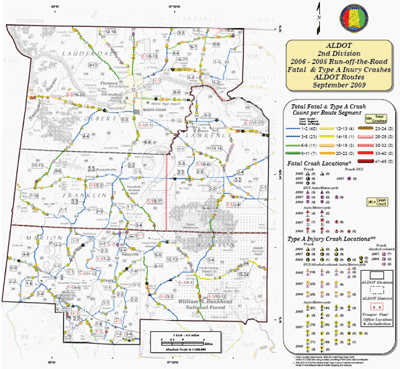|
Search the Noteworthy Practices database Alabama Flexes HSIP Funds for Increased Enforcement – AlabamaOriginal publication: HSIP Noteworthy Practice Series, Use of the HSIP Flexible Funding Provision; FHWA-SA-11-02; 2011 (PDF, 2.8MB)Publication Year: 2011Thirty percent of speeding crashes and 60 percent of roadway departure crashes occur on the 11,000 miles of Alabama’s state highway system. According to Wes Elrod, Transportation Planning and Modal Programs Assistant Bureau Chief, a review of the data and current countermeasures indicated a need for increased enforcement. Until the flex funding option became available in FY 2006, the Alabama Department of Transportation (ALDOT) did not have a mechanism to provide direct financial assistance to the Department of Public Safety (DPS) for increased enforcement on the state system. The Highway Safety Office (HSO) distributes a significant proportion of its National Highway Traffic Safety Administration (NHTSA) funds to local governments and only a limited amount to DPS. Recognizing limited resources for traffic enforcement, ALDOT used HSIP flex funds to increase enforcement strategies identified in the strategic highway safety plan (SHSP) addressing behavior to complement infrastructure improvements and more effectively reduce roadway departure crashes. ALDOT flexed between five and eight percent of its HSIP funds annually from FY 2007 to FY 2010, resulting in $1.5 to $2.8 million spent on noninfrastructure safety projects each of the past four years. The majority of the flex funds paid for overtime for state police troopers to conduct speed enforcement activities, which is a strategy in the state SHSP Risky Driving Emphasis Area. ALDOT worked with the state police to determine how much overtime enforcement they could handle given personnel levels and agreed on an appropriate amount of HSIP funds to flex each year. ALDOT identified fatal and serious injury crash locations and provided crash maps to the state police. Using the Critical Analysis Reporting Environment (CARE) crash records system ALDOT identified the time of day and the type of crashes. Troopers then focused their overtime efforts on those times and locations. ALDOT divided HSIP funds among the 12 state police trooper posts proportionally based on the number of high-crash corridors in each area. ALDOT closely monitored enforcement results and made adjustments as necessary. In quarterly reports, the state police provided the hours worked by each trooper and citations issued during overtime enforcement periods. ALDOT continuously evaluated results to ensure safety goals were met and whether the effort was a successful countermeasure for reducing both speeding and lane departure crashes.
Key Accomplishments
ResultsFlexing HSIP funds for use by DPS for enforcement has resulted in a strong partnership between the state police and ALDOT staff, while addressing noninfrastructure emphasis areas from the SHSP. This effort has resulted in increased deployment of enforcement resources on the state highway system based on crash data. From 2007 to 2009 the number of fatal crashes involving speeding decreased 31 percent, from 369 in 2007 to 255 in 2009. ContactWaymon Benifield Wes Elrod Publication Year: 2011 |
